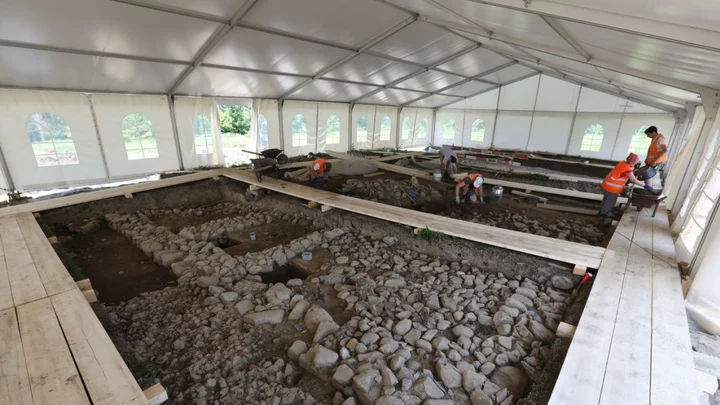
Discovery in Swiss Alps called an 'archaeological sensation'
The remains of 2,000-year-old Roman walls have been discovered by archaeologist in Switzerland in the foothills of the Alps. During the excavation of a gravel pit in Cham in the canton, or state, of Aug in central Switzerland, the walls, which once protected a Roman building complex, were found. Other pieces have also been unearthed by archaeologists, include a plaster wall, iron nails, and gold fragments. As well as items such as bowls, millstones for grinding, glassware, and crockery and ceramic jugs known as amphorae. In a statement form the Office for the Preservation of Monuments and Archeology, the findings were labelled an "archaeological sensation" for the region and could shed light on Roman activity in central Switzerland. Gishan Schaeren, head of the Department of Prehistory and Protohistoric Archaeology said in the statement: "Roman buildings of similar dimensions were last excavated in Cham-Heiligkreuz almost 100 years ago. We were also amazed that the top bricks were even visible above ground." The walls extend over an area of at least 5,300 square feet (500 square metres). Although it's unclear how Romans used the site, including whether it was a "villa with a view or a temple building," said professor of archaeology of the Roman provinces at the University of Bern Christa Ebnöther. The team said that findings of Roman tableware known as terra sigillata - which means "sealed earth" in Latin - were found, suggesting elite people were at the site. The amphorae, which typically held liquids such as wine, olive oil and fish sauce, are evidence that Romans in the region traded with those in the Mediterranean. Archaeologists also found several copper and bronze coins, including a silver denarius minted by Julius Caesar from the first century B.C. The discovery of the Roman walls is not the first ancient find in the area. Previously, archaeologists had found remains of a middle Bronze Age settlement, burials from the late Bronze Age, and a number of coins form the era of the Celts. Sign up to our free Indy100 weekly newsletter Have your say in our news democracy. Click the upvote icon at the top of the page to help raise this article through the indy100 rankings.
2023-09-08 17:27
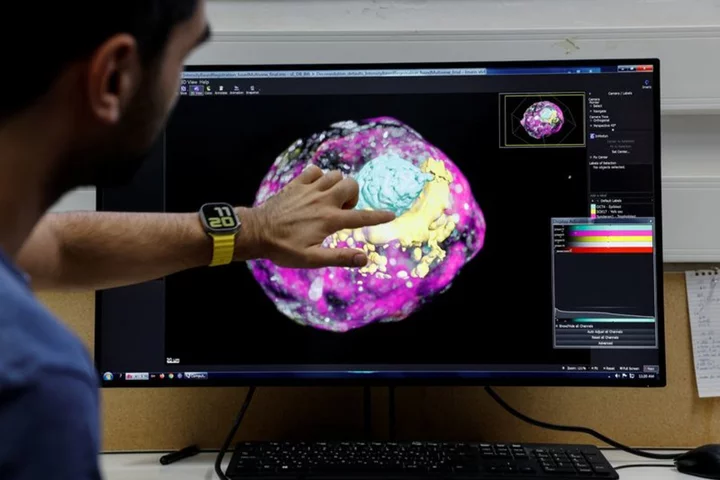
Israeli scientists create model of human embryo without eggs or sperm
REHOVOT, Israel Scientists in Israel have created a model of a human embryo from stem cells in the
2023-09-08 00:56

Behind-the-scenes footage from making of first Grand Theft Auto shows how far franchise has come
A resurfaced clip of the makers of the first GTA game creating the fight scenes is going viral as it shows just how far the franchise has come since 1997. DMA Design Ltd, a Scottish company who created the first game were interviewed by the BBC, and the clip shows one of their employees punching the air while wearing pads to map it out for the animators. When describing how the game would look, they told cameras: "It's a mission-based driving game, where basically you're driving around the city, stealing cars, running over pedestrians... " Sign up to our free Indy100 weekly newsletter
2023-09-07 23:50
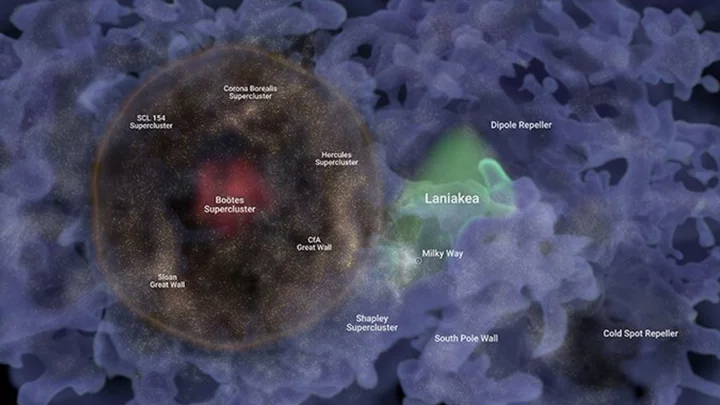
Massive bubble of galaxies could be ‘fossil of the Big Bang’, say scientists
A huge bubble of galaxies that is one billion lightyears across could be a remnant of the ripples caused by the Big Bang, according to astronomers who have mapped the structure. The structure, named Hoʻoleilana by University of Hawaii scientists, is thought to have been caused by so-called Baryon Acoustic Oscillations (BAOs). These were ripples in the particles of the early Universe in the period following the Big Bang, when planets, solar systems and galaxies were not yet fully formed. As the ripples went outward, they created areas of density in the particles, causing bubble-like structures in which galaxies eventually coalesced. Until now, the BAOs were just a prediction – part of the wider Big Bang theory. No specific structures in the Universe had been found which mimicked their patterns. But Hoʻoleilana fits the description of these huge cosmic bubbles perfectly, according to Brent Tully, who led the study at the University of Hawaii’s Institute for Astronomy. “We were not looking for it. It is so huge that it spills to the edges of the sector of the sky that we were analyzing,” he said. “As an enhancement in the density of galaxies it is a much stronger feature than expected. The very large diameter of 1bn light years is beyond theoretical expectations. “If its formation and evolution are in accordance with theory, this BAO is closer than anticipated, implying a high value for the expansion rate of the universe.” The bubble is absolutely huge. It is made up of several superclusters, structures which themselves are thought to be among the Universe’s largest arrangements of matter. This includes the Hercules Supercluster, the Corona Borealis Supercluster and the Sloan Great Wall. All of these structures contain thousands of galaxies. In the middle of Hoʻoleilana sits the Bootes Supercluster and the Bootes Void, an immense space of nothingness which is an incredible 330m lightyears across. Daniel Pomarede, from the CEA Paris-Saclay University, who contributed to the research, said: “It was an amazing process to construct this map and see how the giant shell structure of Ho’oleilana is composed of elements that were identified in the past as being themselves some of the largest structures of the universe.” The research was published on 5 September in The Astrophysical Journal. Sign up to our free Indy100 weekly newsletter Have your say in our news democracy. Click the upvote icon at the top of the page to help raise this article through the indy100 rankings.
2023-09-07 19:45
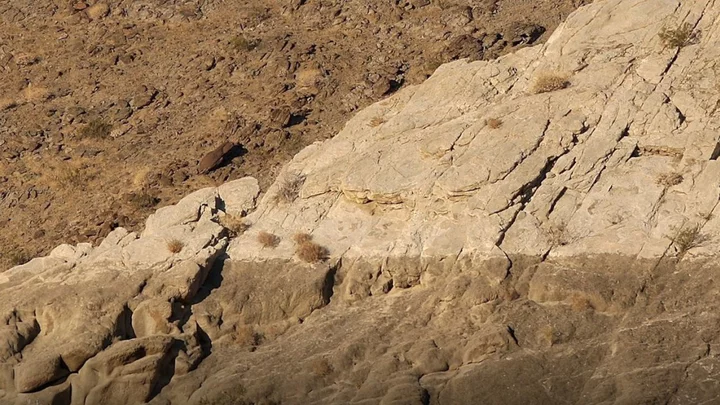
There’s a ‘lost continent’ which holiday makers have been visiting without knowing
Tourists from across the world may have been holidaying on the remains of a 'lost continent' that's been hiding in plain sight. The continent, known as Greater Adria, reportedly broke off from North Africa almost 250 million years ago. Around 120 years later, it started sinking under parts of Southern Europe including the Alps, the Apennines, the Balkans and Greece. Douwe van Hinsbergen, Professor of Global Tectonics and Paleogeography at Utrecht University, said: "Forget Atlantis. Without realising it, vast numbers of tourists spend their holiday each year on the lost continent of Greater Adria." He added: "The only remaining part of this continent is a strip that runs from Turin via the Adriatic Sea to the heel of the boot that forms Italy." This isn't the first time a 'lost' continent has been discovered... Scientists uncovered Zealandia (or Te Riu-a-Māui in the Māori language) that was reportedly 'lost' for 375 years. In the past, there's been speculation as to whether the continent actually exists. It wasn't until 2017 that geologists discovered the continent had been there all along. According to TN News, Zealandia is 1.89 million square miles in size. It was part of a supercontinent called Gondwana, which included most of Western Antarctica and Eastern Australia, over 500 million years ago. It was first said to have first discovered in 1642 by Dutch businessman and sailor Abel Tasman, who was desperate to uncover the "Great Southern Continent". Scientists agreed on the existence of Zealandia, which started to "pull away" from Gondwana for reasons scientists are still trying to understand. Most of the newfound continent is underwater and has been used as an example by geologists at the Zealand Crown Research Institute GNS Science on how something "very obvious" can take a while to uncover. Sign up for our free Indy100 weekly newsletter Have your say in our news democracy. Click the upvote icon at the top of the page to help raise this article through the indy100 rankings.
2023-09-07 16:52

UK rejoins EU science research scheme Horizon
UK-based scientists and institutions will have access to the £85bn fund from today.
2023-09-07 16:50

Britain rejoins EU's Horizon science programme with "bespoke" agreement
LONDON Britain announced on Thursday it would rejoin the European Union's flagship Horizon science research programme in a
2023-09-07 14:21

F1: Cardiff teens aim for glory in school competition
Five school pupils have reached the finals of an internationally renowned Formula 1 competition.
2023-09-07 14:20
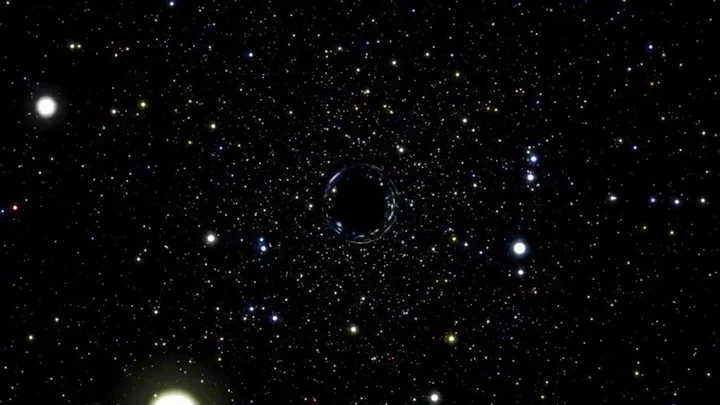
Scientists confused after black holes 'burp up' previously destroyed stars
It feels like every time black holes are discussed and studied by the scientific community, there are new findings that blow our tiny minds. It’s been revealed that black holes actually regurgitate or “burp up” the stars that they eat years after the event. Experts made the discovery by studying tidal disruption events (TDEs). These events take place when stars are close enough to supermassive black holes, to be destroyed by the process of spaghettification. Studying these moments over a number of years after the black holes seemingly swallowing stars with no trace, the experts found that up to 50 per cent of them "burp up" the remains. Yvette Cendes is a research associate at the Havard and Smithsonian Center for Astrophysics and head author on the study. Speaking to Live Science, she said: "If you look years later, a very, very large fraction of these black holes that don’t have radio emission at these early times will actually suddenly 'turn on' in radio waves. "I call it a 'burp' because we’re having some sort of delay where this material is not coming out of the accretion disk until much later than people were anticipating." The material was re-emitted between two and six years from 10 out of 24 black holes which were studied by Cendes and the team. It has the potential to change the way the scientific community thinks about black holes. "There was a second peak, the two black holes re-brightened, and that's completely new and unexpected," Cendes said. "People were thinking that you'd have one outflow, and then it's kind of done. So this observation means these black holes can 'turn on' and then 'turn on' again." Meanwhile, a low intergalactic grumbling is emanating from deep space, according to scientists – and again, it’s black holes that are providing us with new discoveries. Astronomers say they detected the first-of-their-kind low frequency ripples, described as a “cosmic bass note” of gravitational waves, which is thought to be caused by supermassive black holes merging across the universe. Sign up for our free Indy100 weekly newsletter Have your say in our news democracy. Click the upvote icon at the top of the page to help raise this article through the indy100 rankings
2023-09-07 00:29

UK expected to re-join Horizon science scheme
An announcement is likely soon on the UK becoming a fully-fledged member of the multi-billion euro programme.
2023-09-06 23:54

Frozen humans could be brought back to life in next 50 years claims expert
Experts may have found a way to resurrect frozen humans in 50 to 70 years. It comes after a cryonics company was able to revive an extinct worm from 46,000 years ago, leading them to believe the method could be applied to humans. "Cryonics is a scientifically based, legal technology for preserving humans and animals in a state of deep cooling in the hope that in the future they will be resuscitated and, if necessary, cured and rejuvenated," Russian cryogenics company KrioRus explained. "For legal reasons, human cryopreservation can be carried out only after legal death." KrioRus shared how the dead patient is "immersed into a low-temperature medium where almost all chemical reactions are stopped." The first ever cryopatient, American professor James Bedford, has been preserved for almost 50 years "with no sign of change or deterioration." "In the prognosis of modern science, a cryopatient can indeed be someday revived and return to life," they said. Many more people have opted to freeze their deceased pets, with costs dependent on pet size, species and distance to the facility among other factors. A dog is said to cost around $25,000. The company claims to have cryopreserved 92 people but disclaimed that for humans to be resurrected, there must be significant progress in the medical field. "Cryobiological laboratories are few, there are no large ones at all," CEO Valeriya Udalova told MailOnline. "Even the famous laboratory 'XXI Century Medicine' is a small organization." She continued: "But even in such a deplorable situation, remarkable experiments have already been made, for example, on reversible cryopreservation of a rat kidney using gas persufflation with nanoparticles and induction heating." Sign up for our free Indy100 weekly newsletter Have your say in our news democracy. Click the upvote icon at the top of the page to help raise this article through the indy100 rankings.
2023-09-06 21:23

One of the biggest 'cities' ever on Earth was not built by humans
Scientists who were attempting to map an abandoned ant hill didn't expect to find a mega-city when they shot the hill full of cement, but that's exactly what they discovered. Over three days, scientists pumped 10 tons of cement into the empty ant hill to map its networks. After the cement dried, they dug for weeks around it. The excavation revealed an incredibly impressive, intricate, and bizarre ant mega-city. The mega-city was a truly colossal undertaking. A video revealed that the ants created the structure by displacing 40 tons of dirt. And it really is a mega-city. The ants networked to disposal pits and fungus gardens. Each tunnel was designed to ensure thorough ventilation and reduce transport time. The narrator disclosed the truth. That despite the complex nature of the mega-city, there was no single architect of any - but it was down to the collective will of the colony. "Everything looks like it has been designed by an architect a single mind but of course, that isn’t true," they said. "This colossal and complex city was created by the collective will of the ant colony, the super organism." The short resurfaced clip is from a much longer piece called Ants! Nature’s Secret Power. You can watch the full documentary here. Our city designers should take a few notes. Sign up to our free Indy100 weekly newsletter Have your say in our news democracy. Click the upvote icon at the top of the page to help raise this article through the indy100 rankings.
2023-09-06 20:26
